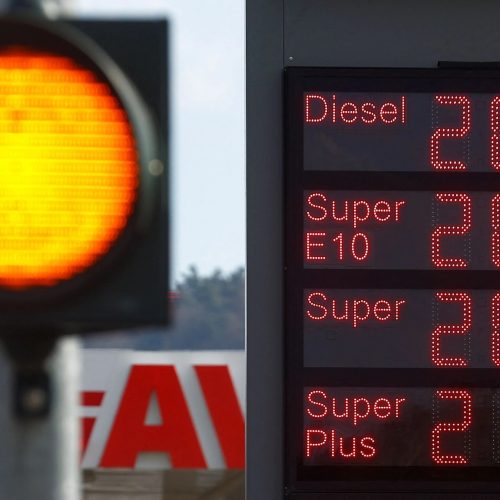
After being incessantly driven higher in the grip of supply fears for the better part of the past four months, crude prices have begun to yield to the risk-aversion enveloping the broader financial markets amid growing recessionary fears.
Worries over a secular softening of oil demand in the near future have been reinforced by macro-economic data in recent days indicating that major economies are rapidly slowing down and consumer confidence and spending is starting to buckle under stubborn and red-hot inflation.
The US Bureau of Economic Analysis last week downgraded first-quarter GDP to 1.6% contraction, from the previous estimate of a 1.5% drop and contrasting with a growth of 6.9% in Q4 2021.
Consumer spending, which accounts for over two-thirds of US GDP, was downgraded to a growth of 1.8% for the quarter from 3.1% estimated last month.
The mood in the financial markets was dampened by US and European central bank heads warning that the era of low interest rates and moderate inflation had come to an end.
Speaking alongside his peers at the European Central Bank’s annual conference, US Fed Chairman Jerome Powell said he was more concerned about the risk of failing to squash inflation than the possibility of raising rates so high that they push the economy into a recession.
Gasoline demand in the US, world’s largest consumer, has been stuck below corresponding year-ago levels since April and recent days’ data shows it has been declining even in the midst of the peak summer driving demand season. European data comes with a lag, but we expect oil demand in the continent would be faring much worse.
GREEN SHOOTS IN CHINA
Meanwhile, quite divergent from the trend in the rest of the world, green shoots are popping up in the Chinese economy, after Covid lockdowns and restrictions dampened travel and commercial activity over the past few months.

China reported a modest recovery in factory activity in June. The official Purchasing Managers’ Index for the manufacturing sector came in at 50.2 for the month, the first expansion since February.
As the country gradually eases Covid restrictions with a fall in cases, travel and commercial activity are expected to start picking up pace.
The Chinese government last week issued 52.66 million mt of crude import quotas to 36 independent refiners, up 49% from the same slot last year.
Refiners in the country are expected to start ramping up processing rates in anticipation of a gradual recovery in domestic fuel demand.
China’s return to normalcy, however, will remain vulnerable to the vagaries of the coronavirus. The government last week announced plans to halve quarantine requirements for overseas visitors nationwide to seven days but did not give a start date.
At the same time, Beijing poured cold water over speculation that it may be preparing to loosen its strict “zero-Covid” policy by stressing that it will not waver from the practice of mass-testing, lockdowns and other curbs to squash any further outbreaks.
RUSSIA SUPPLY FEARS RECEDING
Russian Deputy Prime Minister Alexander Novak reinforced a growing consensus view in the market that the country is managing to place most of its crude being rejected by the EU into Asia.
The rerouting helped Russian crude production rise to 9.9 mil b/d in June from 9 mil b/d in March and April, Novak said, adding that it was expected to climb to pre-sanction levels through summer.
Leaders of the G7 countries agreed to explore the feasibility of introducing temporary limits on what prices buyers may pay for Russian crude and refined products, at a summit in Germany. The news buoyed crude for a few days, but the upward thrust did not last.
We don’t see the plan coming to fruition. It will need the EU’s sixth package of sanctions against Russia, agreed at the start of June, to be reopened to not only overturn a ban on European companies providing shipping insurance for Russian oil, but to actually involve them in implementing the price cap.
The proposal envisages allowing European insurance for the shipment of Russian cargoes bought and sold under a pre-agreed price cap.
The price cap plan is complicated and will be extremely cumbersome to design and implement, something that European officials have openly acknowledged.
Among the major questions that need answering is who will decide the cap and how, and whether the insurance companies will be willing and able to take responsibility for implementing it.
EU officials have expressed reservations over getting the bloc’s 27 members to agree to modifying the shipping ban.
India has demanded to see details of the price cap mechanism before deciding whether it would be willing to participate in the coalition of willing buyers, while China is expected to steer clear, given President Xi Jinping’s pledge of full support for Russia and his counterpart Vladimir Putin after the Ukraine invasion.
However, the market’s supply-side bullishness is expected to persist even if concerns over Russian supply continue to ease.
The majority of OPEC/non-OPEC producers are struggling to ramp up while still pumping well below their targets, while geopolitical risks to supply persist in producer countries ranging from Libya to Ecuador, and an “above normal” Atlantic hurricane season could threaten the 1.7 million b/d of offshore US Gulf of Mexico production and nearly 8 million b/d of refining capacity in Texas and Louisiana at any time in the coming months.
The way down for crude prices, even in the face of growing economic headwinds, could be a long and winding one.
Vandana Hari is Founder and CEO of Vanda Insights, which provides macro-analysis of the global oil markets.
READ MORE..
Deceptive Solutions for Fossil Fuel Dependence Drive Prices Higher (Article)
Deceptive Solutions for Fossil Fuel Dependence Drive Prices Higher (Article)
The Biden Administration’s policies have pushed gasoline prices higher (Article)
(Article) The Top 5 Reasons Behind Fruitless Energy Policies
The Biden Administration’s policies have pushed gasoline prices higher (Article)








